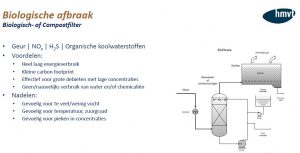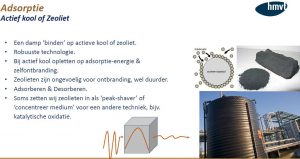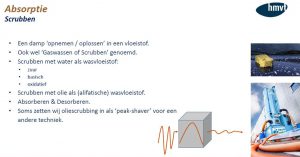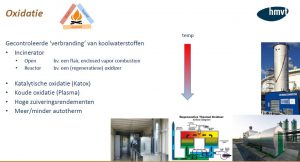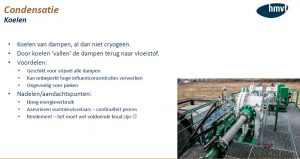On Tuesday November 10, HMVT organized its first webinar as part of a series of webinars about HMVT’s expertise. This way, we still come together during corona times and we keep each other updated on the knowledge and skills in the field. Marco van den Brand and Michiel Hennink kicked off with the topic “Industrial vapor cleaning “.
There are five ways in which industrial vapor cleaning can be carried out: biological, adsorption, absorption, oxidation, or condensation. These five “flavours” form the palette with which experts clean industrial vapors. Combinations are possible. When do you use which technique and what are the advantages and disadvantages of these techniques? In this blog we briefly summarize the webinar. Would you like to receive the entire presentation, or do you want to know more? Send Marco an email.

Biodegradation
Biodegradation has advantages and disadvantages. For example, the energy consumption is very low, and it often has only a small carbon footprint. However, biological vapor cleaning is very sensitive to moisture, temperature, acidity, and concentration peaks.
Adsorption
Adsorption, or “binding” a vapor on activated carbon or zeolite, is a robust technology. Zeolites are insensitive to combustion (which activated carbon is sensitive to) but are much more expensive. HMVT sometimes uses zeolites as a “peak shaver”.
Absorption
With adsorption, also called “gas washing or scrubbing”, you kind of scrub the vapor clean. The washing liquid is often an acid, basic or oxidative, but oil can also provide a solution. Oil scrubbing is also used as a “peak shaver”.
Oxidation
With oxidation, a controlled “combustion” takes place, often at a high concentration and low flow. The advantage of this technique is that it leaves you with high purification yields. HMVT has a lot of experience with Katoxes, which provide low-temperature oxidation and are NOx-free. It is also possible to oxidize with cold plasma. This ensures low energy consumption and a small carbon footprint. HMVT will soon be conducting the first (odour) tests.
Condensation
When condensing, you cool the vapors, causing the vapors to condense into liquid. This is possible with almost all vapors, but it requires a lot of energy.
Comments
After the webinar, HMVT received positive responses to the first webinar.
Klaas de Jong, Water and Process Technology Consultant at KWA Bedrijfsadviseurs: “In a short and powerful presentation, the various air treatment techniques were presented. Advantages and disadvantages of various techniques were briefly reviewed. Good to be informed again!”.
Marco is delighted with the positive reactions: “The first webinar was a success. It is nice to be able to share your subject of expertise with others as professionals. On to the next webinar!”
SAVE THE DATE: December 10, 2020
HMVT will continue the series of webinars with a webinar on Constructed Wetlands on Thursday December 10th, 2020. HMVT will soon provide a registration form. Already interested? Send Marco an email.
Preview of the presentation


